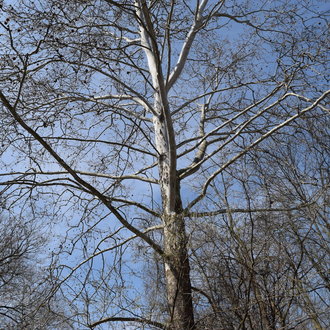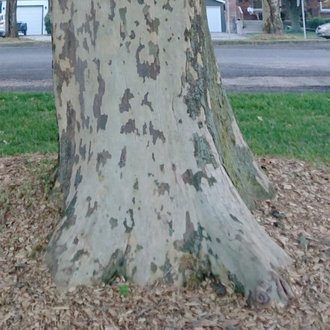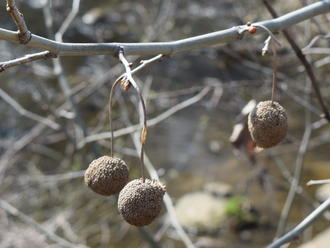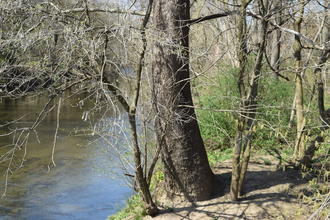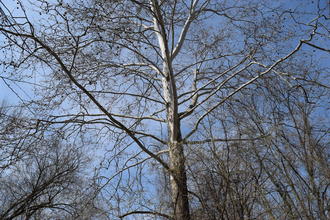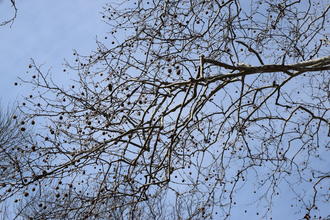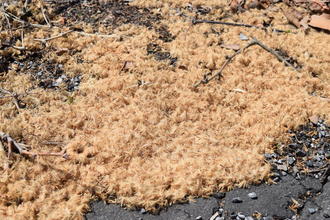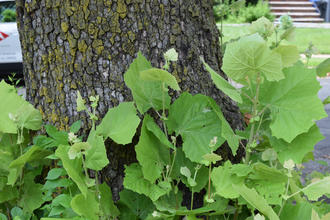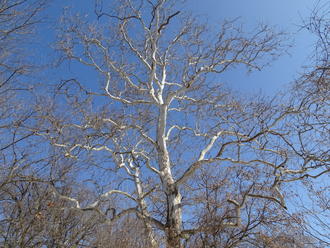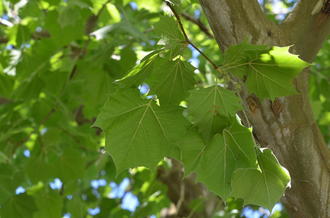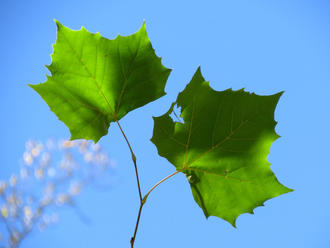American Sycamore (Platanus occidentalis L.)
Also known as American planetree.
↑Summary
A large native tree of floodplains and riparian areas, with characteristic mottled bark, especially higher up on trunk and upper branches.
↑Range - Expand
| Legend | Color |
| Native | |
| Native or Not Present | |
| Extirpated | |
| Introduced or Not Present |
This tentative map is based on our own research. It may have limited data on Canada and/or Mexico, and there is some subjectivity in our assignment of plants as introduced vs. expanded. Read more in this blog post.
Although this plant occurs somewhere in each of these regions, it may only occur in a small part of some or all of them.
This species has been widely planted in plantations, from which it often escapes due to its large number of wind-dispersed seeds that can travel long distances. We mark the New Mexico population introduced because it is separated from the native range. It has been locally extirpated from southern Maine, but has also been re-introduced into Maine farther north and west, through plantations.
↑Similar Plants
↑Habitat
Mostly found in bottomland woodlands and floodplains, often growing right up to the water's edge, or even in sandbars or small islands in streams and rivers. Less commonly found in wetter areas of more upland habitats. Also found on coal mine spoils. In the north of its range it is also found on swampy ground and in poorly-drained depressions. In the southernmost parts of its range it is also found in coves and on lower, north- and east-facing slopes.
Mostly found on alluvial soils, but tolerates a wide range of soil types and textures, including sand, clay, peat and muck, in addition to fertile loams. Growth is best on loam to sandy loams with access to ample water. Tolerates poor drainage and significant temporary flooding, especially in winter; tolerance of soil saturation and poor drianage is greater in the north of its range than the south, and is reduced during the growing season.
Occupies different successional stages on different sites. Needs significant direct sunlight and moisture, although it can tolerate some shade. On bottomlands, occupies a later successional stage than willows, river birch, and cottonwood; often persists indefinitely on sites experiencing enough flooding or other disturbance to result in periodic gap creation. On less-disturbed bottomlands, occupies mid-successional stages, and is replaced by more shade-tolerant species including elm, red maple, bitternut hickory, or various bottomland oaks. On uplands, it is strictly a pioneer species, and its presence indicates a past disturbance larger in scale than a few isolated trees.
Limited to lower elevations; reaches from sea level to about 1,000 ft (305m) in the north, and up to 2,500 ft (762m) in the south of its range.
Limited to sites where fire does not occur, both due to its thin bark which leaves adult trees susceptible to fire, and its inability to colonize recently-burned sites.
↑Life Cycle
American sycamore is a rapidly growing but long-lived tree that is typically among the largest canopy trees in its habitat.
Seedlings require significant direct sunlight to survive. Seedlings can often survive a few weeks of flooding but will be killed if flooded for two months.
Trees tend to begin producing seed at 25 years of age, although trees grown in plantations or landscaping in ideal conditions may produce seed as early as 6-7 years. Seed production peaks between 50 and 200 years.
Seeds are wind-dispersed, and due to this species presence in floodplains and along waterways, a significant portion of the seeds land in water, and are further distributed by water. Seed distribution is timed so as to take advantage of a time when water levels tend to be decreasing, leading many seeds to be distributed on mudflats and sandbars in and along rivers and streams.
Seeds germinate in response to high light conditions, and also require significant moisture and warm temperatures. Germination is inhibited by deep litter.
Trees resprout vigorously from the stump when cut or sometimes even at the base of healthy trees when a gap opens up additional light. Saplings have the greatest resprouting potential, and resprouting ability declines with age, making saplings the most resilient phase of this species life cycle.
Trees often live over 250 years, with death of mature trees occurring gradually, brought on by rot and insect infestation facilitated by mechanical damage. This species is susceptible to ice damage, and unusually severe ice storms often cause major damage to mature trees. Although trees are usually windfirm, heavy winds can cause the wood to crack, contributing to decay in the long-term. Although this species is usually found in habitats that do not burn, when it is exposed to fire, it is a major cause of mortality. Trees are readily killed by severe fire due to their thin bark; lower intensity fires can damage the bark, leading to later mortality by rot and insects.
↑Faunal Associations
The seeds are eaten by various songbirds, including the purple finch, goldfinch, chickadees, and dark-eyed junco, and to some degree by mammals, including muskrat, beaver, and squirrels. Beavers also consume the bark. Deer occasionally browse the foliage and twigs.
Larger trees with decaying wood are important nesting sites for cavity-nesting birds, including barred and screech owls, wood ducks, chimney swift, and great-crested flycatchers. The largest, oldest trees develop hollow trunks which are sometimes used as nesting sites for black bears; smaller cavities may be used by squirrels or bats.
American sycamore is often one of the largest trees in the bottomland forests in which it occurs, and is a key structural component of these forests, forests which are rich in biodiversity. As such its indirect importance to the whole ecosystem is great.
Numerous insects eat the foliage and other parts of this tree, but rarely cause any serious damage to wild trees. The sycamore tussock moth (Halysidota harrisii) specializes on this species; its larvae are camouflaged relative to the seedheads. The drab prominent (Misogada unicolor) moth eats this along with Populus sp. which often grow in the same habitat. Sycamore is also the preferred host of a large number of Eratoneura leafhoppers.
Trees grown in landscaping and/or timber plantations are often more susceptible to insects.
↑Uses
Sometimes planted as a landscaping plant, especially in parks and large yards with ample space.
This species is one of the more commercially important trees in North America. The wood is relatively desireable; it is similar to maple, with a fine and even grain. It is easy to work with, but not particularly durable. The rapid growth of this species and its large maximum size also makes it attractive for timber production. It is widely planted in plantations, sometimes mixed with other species including cherrybark oak.
It can used for coppicing, but is often limited in the number of times it can be harvested in this manner.
It is also sometimes planted on areas degraded by coal mining, and is effective for reclaiming these lands. In many cases, however, it seeds onto these sites on its own and does not need any assistance.
↑Related Plants
The American Sycamore is the only species of its genus in the vast majority of its range; in urban areas, however, the london planetree (Platanus ×hispanica), possibly a hybrid of this and Platanus orientalis, or possibly a cultivar of that species alone, is widely planted, and this hybrid or variety has become established in some wild populations, mostly near New York City.
Two other Platanus species occur in southwestern North America, but they do not overlap with this species in range.
↑Links & External Resources
• Sycamore | The Wood Database (About This Site)
• American Sycamore | Fire Effects Information System (FEIS) (About This Site)
• Platanus occidentalis (American Sycamore) | Illinois Wildflowers (About This Site)
• Platanus occidentalis (American Sycamore) | USDA PLANTS Database (About This Site)
• Platanus occidentalis | Go Botany (About This Site)
• Platanus occidentalis (American Sycamore) | Missouri Botanical Garden Plant Finder (About This Site)
• American Sycamore | Virginia Tech Dendrology Factsheets (About This Site)
• Sycamore | Silvics of North America (About This Site)
• Platanus occidentalis | Biota of North America Project (BONAP) (About This Site)
• Platanus occidentalis | NatureServe Explorer (About This Site)
• Platanus occidentalis | Flora of North America (About This Site)
• American Sycamore | Maryland Biodiversity Project (About This Site)
• Platanus occidentalis L. (Sycamore, American Sycamore) | Digital Atlas of the Virginia Flora (About This Site)



